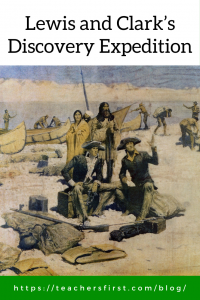“Amazing the things you find when you bother to search for them.”
Sacagawea
Two hundred and fifteen years ago, on September 22, 1806, Lewis and Clark arrived in St Charles, MO—their last stop before reaching their final destination of St. Louis, ending the first recorded overland journey from the Mississippi River to the Pacific coast and back. Lewis and Clark headed up the westward expedition, also known as the Corps of Discovery Expedition, as part of Thomas Jefferson’s mission to find a water route to the Pacific.
Studying Lewis and Clark’s journey is a great opportunity that offers students a variety of ways to learn about the past. Allowing students to research areas of interest engages them and gives them ownership over their learning.
Using Lewis and Clark as an example, let’s look at some ideas for engaging students in learning about westward expansion while providing a variety of learning choices.
Introduction:
- Discovering Lewis & Clark (reviewed here) is an excellent site with over 2,100 pages of information related to Lewis and Clark. Share this site with students to explore either individually or in groups. Use Google Jamboard (reviewed here) to create a collaborative board where students can use sticky notes to share interesting tidbits. Add a frame (Jamboard’s name for a slide) for additional support questions such as “What do I want to explore further?”, or add frames as needed for information learned about the territories explored during the journey.
- Engage students with literature. For example, use TeachersFirst Reading Treks for The Journey of York, The Unsung Hero of the Lewis and Clark Expedition and Buffalo Dance: The Journey of York to lead students on virtual field trips about the journey of Lewis and Clark. Reading Treks include class activities, lesson suggestions, and an interactive map with pop-up information related to locations featured in each book.
Exploration and Research:
Brainstorm possible topics for students or groups to research related to Lewis and Clark and westward expansion. Some ideas include:
- Explorers – What other explorers contributed to westward expansion? What were the lives of Lewis and Clark like before and after the expedition?
- Native Americans – What kind of interactions did Lewis and Clark have with Native Americans? How did westward expansion affect the Native American communities?
- Westward Expansion – What was westward expansion? How did it change the United States as a country? What obstacles did explorers and frontier settlers face? How and why did they choose the paths they took?
- Animals – What are some of the animals discovered in the new territory? What made these discoveries necessary?
- Map Making – What tools were used to map and record the new territory? How are they different than those used today? What might this journey look like if this exploration took place 100 years later? How might it look today?
Organizing and Sharing Student Learning:
Students have different interests and skills. These tools provide a variety of ways to help organize and share their research.
- 3X3 Links (reviewed here) – As students find sites to use in their research, suggest using an easy curation tool like 3X3 links to organize and save links. This example demonstrates how to share resources with your class that they can use as they research information.
- Wikipedia Timeline Generator (reviewed here) – Timelines are always helpful as a visual aid for understanding events over time. Type “Lewis and Clark Expedition” in this easy timeline generator to view an exploration overview.
- SuperNotecard (reviewed here) – Use this tool to create and share notes collaboratively. Users can drag and drop to arrange notes and add color codes to organize information. For example, use a different color for each group member so you can identify who shared the information. Then, rearrange notes throughout the research process to create a storyboard for a final presentation.
Consider offering students options for sharing their projects, such as:
- Google My Maps (reviewed here) – Create interactive maps that include information about stops along Lewis and Clark’s expedition. Include links to videos, images, websites, and more.
- Canva Timeline Infographic Templates (reviewed here) – Use Canva templates to create timelines and infographics to share data about the expedition.
- Scratch (reviewed here) – Create an animated story using Scratch’s coding features. Search for “Lewis and Clark” to find examples created and shared by students.
- Minecraft (reviewed here) – Use these Minecraft project directions to explore Lewis and Clark’s journey while building scenes of events at various stops along the way.
- Anchor (reviewed here) – Create a multi-episode podcast that shares Lewis and Clark’s journey west. Anchor makes it easy to record from any device and to import existing video and audio. This curriculum guide shares helpful tips for implementing podcasting into any lesson. Share this podcast with students to serve as a sample podcast about explorers; scroll down the playlist to find the Lewis and Clark episodes.
- Google Sites (reviewed here) – Create a website to share learning. Include links to student-created videos, interactive images, and storytelling content. Ask one of your more tech-savvy students to create a Google Site that compiles and shares all of the different research projects developed by your students.
Learning about explorers involves much more than viewing a map and timelines. Exploring the people and how the expedition was affected by the time period and by other historical events provides a broader perspective and a more meaningful understanding of what happened. As an added benefit, students gain a deeper understanding of information by sharing their learning through many different methods.
Do you have a favorite tool or resource for teaching about explorers? We would love to hear your strategies in the comments below as we learn together!


